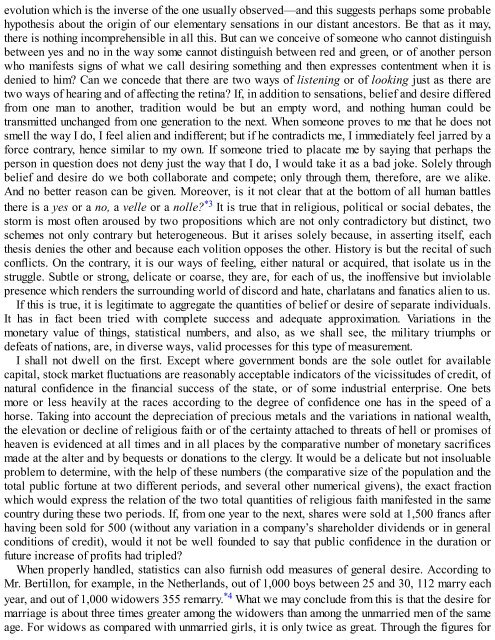3658925934
You also want an ePaper? Increase the reach of your titles
YUMPU automatically turns print PDFs into web optimized ePapers that Google loves.
evolution which is the inverse of the one usually observed—and this suggests perhaps some probable<br />
hypothesis about the origin of our elementary sensations in our distant ancestors. Be that as it may,<br />
there is nothing incomprehensible in all this. But can we conceive of someone who cannot distinguish<br />
between yes and no in the way some cannot distinguish between red and green, or of another person<br />
who manifests signs of what we call desiring something and then expresses contentment when it is<br />
denied to him? Can we concede that there are two ways of listening or of looking just as there are<br />
two ways of hearing and of affecting the retina? If, in addition to sensations, belief and desire differed<br />
from one man to another, tradition would be but an empty word, and nothing human could be<br />
transmitted unchanged from one generation to the next. When someone proves to me that he does not<br />
smell the way I do, I feel alien and indifferent; but if he contradicts me, I immediately feel jarred by a<br />
force contrary, hence similar to my own. If someone tried to placate me by saying that perhaps the<br />
person in question does not deny just the way that I do, I would take it as a bad joke. Solely through<br />
belief and desire do we both collaborate and compete; only through them, therefore, are we alike.<br />
And no better reason can be given. Moreover, is it not clear that at the bottom of all human battles<br />
there is a yes or a no, a velle or a nolle? *3 It is true that in religious, political or social debates, the<br />
storm is most often aroused by two propositions which are not only contradictory but distinct, two<br />
schemes not only contrary but heterogeneous. But it arises solely because, in asserting itself, each<br />
thesis denies the other and because each volition opposes the other. History is but the recital of such<br />
conflicts. On the contrary, it is our ways of feeling, either natural or acquired, that isolate us in the<br />
struggle. Subtle or strong, delicate or coarse, they are, for each of us, the inoffensive but inviolable<br />
presence which renders the surrounding world of discord and hate, charlatans and fanatics alien to us.<br />
If this is true, it is legitimate to aggregate the quantities of belief or desire of separate individuals.<br />
It has in fact been tried with complete success and adequate approximation. Variations in the<br />
monetary value of things, statistical numbers, and also, as we shall see, the military triumphs or<br />
defeats of nations, are, in diverse ways, valid processes for this type of measurement.<br />
I shall not dwell on the first. Except where government bonds are the sole outlet for available<br />
capital, stock market fluctuations are reasonably acceptable indicators of the vicissitudes of credit, of<br />
natural confidence in the financial success of the state, or of some industrial enterprise. One bets<br />
more or less heavily at the races according to the degree of confidence one has in the speed of a<br />
horse. Taking into account the depreciation of precious metals and the variations in national wealth,<br />
the elevation or decline of religious faith or of the certainty attached to threats of hell or promises of<br />
heaven is evidenced at all times and in all places by the comparative number of monetary sacrifices<br />
made at the alter and by bequests or donations to the clergy. It would be a delicate but not insoluable<br />
problem to determine, with the help of these numbers (the comparative size of the population and the<br />
total public fortune at two different periods, and several other numerical givens), the exact fraction<br />
which would express the relation of the two total quantities of religious faith manifested in the same<br />
country during these two periods. If, from one year to the next, shares were sold at 1,500 francs after<br />
having been sold for 500 (without any variation in a company’s shareholder dividends or in general<br />
conditions of credit), would it not be well founded to say that public confidence in the duration or<br />
future increase of profits had tripled?<br />
When properly handled, statistics can also furnish odd measures of general desire. According to<br />
Mr. Bertillon, for example, in the Netherlands, out of 1,000 boys between 25 and 30, 112 marry each<br />
year, and out of 1,000 widowers 355 remarry. *4 What we may conclude from this is that the desire for<br />
marriage is about three times greater among the widowers than among the unmarried men of the same<br />
age. For widows as compared with unmarried girls, it is only twice as great. Through the figures for









![Genki - An Integrated Course in Elementary Japanese II [Second Edition] (2011), WITH PDF BOOKMARKS!](https://img.yumpu.com/58322134/1/180x260/genki-an-integrated-course-in-elementary-japanese-ii-second-edition-2011-with-pdf-bookmarks.jpg?quality=85)
![Genki - An Integrated Course in Elementary Japanese I [Second Edition] (2011), WITH PDF BOOKMARKS!](https://img.yumpu.com/58322120/1/182x260/genki-an-integrated-course-in-elementary-japanese-i-second-edition-2011-with-pdf-bookmarks.jpg?quality=85)





